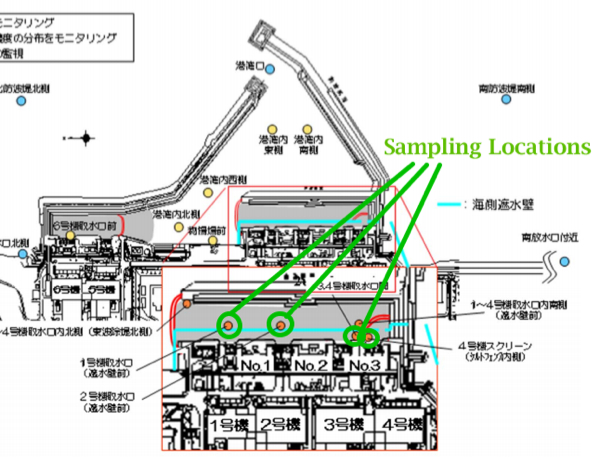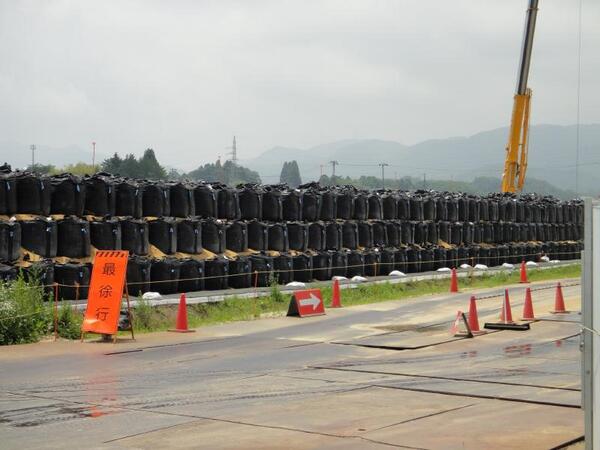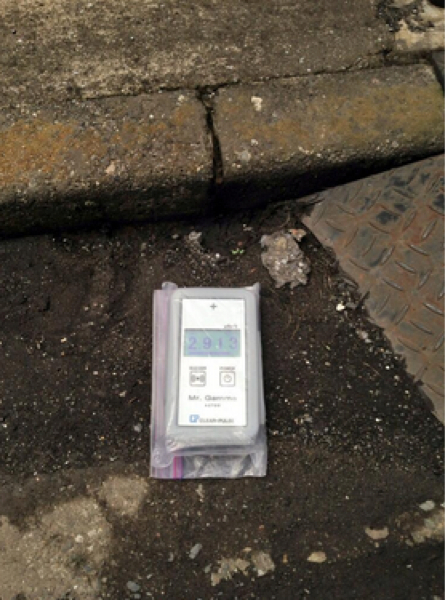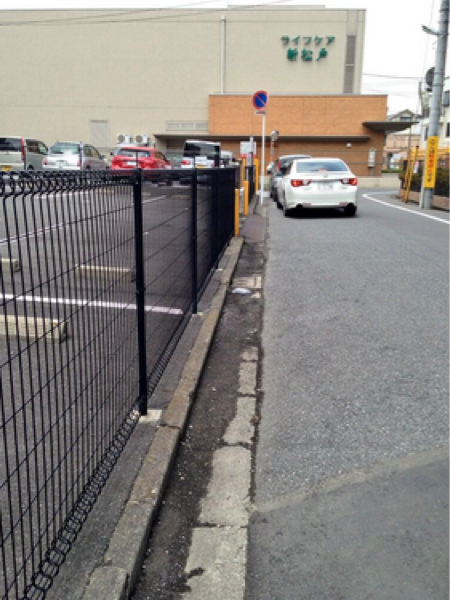Fukushima Diary.....
Iori Mochizuki
Iori Mochizuki
Iori Mochizuki
Tepco to cover the 180,000 m2 of sea bed of Fukushima plant port with concrete
Posted by Mochizuki on June 29th, 2014 · 2 Comments
On 6/26/2014, Tepco announced that they are going to start covering the sea bed of Fukushima plant port with concrete.
It’s 180,000 m2. Tepco states they will start the construction in the end of this month and complete by the end of next March.
Tepco also commented they measured 190,000 Bq/kg of Cs-134/137 from the soil of the sea bed. The covering is to stop the highly contaminated soil spreading over.
Japanese Gov advertises for worldwide ideas to remove molten fuel from 3 crippled reactors
Posted by Mochizuki on June 29th, 2014 · No Comments
On 6/27/2014, Ministry of Economy, Trade and Industry announced to advertise for the ideas to remove molten fuel from Reactor1, 2 and 3 domestically and internationally.
Tepco has been planning to fill the crippled reactors with water and remove the fuel from the top in 6 years. However they are starting to be aware of the difficulty to identify the leaking part on the reactors and repair to fill with water.
They therefore are seeking the alternative idea such as removing molten fuel from the side of the reactors etc..
Highest density of Tritium measured from seawater of all of the crippled reactors even outside of underground wall
Posted by Mochizuki on June 28th, 2014 · No Comments
On 6/27/2014, Tepco announced they measured the highest density of Tritium from Fukushima plant port.
The sample seawater was taken in water intake of Reactor1, 2, and 3&4, and also the screen of Reactor4.
Currently Tepco is building the major underground wall inside of the plant port. (cf, Tepco is filling up a part of Fukushima plant port [URL]) However the highest density of Tritium was measured at 2 sampling locations outside of this wall to question the effectiveness of the wall.
The sampling date was 6/23/2014. The lowest density was 230,000 Bq/m3, the highest density was 2,500,000 Bq/m3 in front of water intake of Reactor3&4.
No explanation has been announced.
[Photo] A heap of removed soil for decontamination in Minamisoma
Posted by Mochizuki on June 28th, 2014 · No Comments
A Japanese citizen in Minamisoma posted on Twitter a picture of the heap of soil that was removed for decontamination.
“・・・ This is the temporary storage area. I found this when I was riding a bicycle along the street from Hibari-gahara to AEON MALL.
・・・ The black bags are piled like a heap. Cranes are like a forest in the vast area to pile more black bags. I was stunned to think they are going to transfer them somewhere one day.”
Bleeding hand decontamination volunteer “Had pharyngeal cancer and now have bone ache”
Posted by Mochizuki on June 28th, 2014 · 4 Comments
Following up this article.. [Photo] Fukushima decontamination volunteer “Blood suddenly splashes out of skin quite often. This is the reality.” [URL]
He commented on Twitter that he experienced pharyngeal cancer and is suffering chronic fatigue and bone ache.
“・・・I had ablative operation in Shonankamakura General Hospital and managed to remove pharyngeal cancer. The result of vital histological examination told it was malignant tumor. Now I’m suffering from chronic fatigue and bone ache.”
None of the details about the fatigue and bone ache are mentioned.
[Photo] 4.3 μSv/h on the street of Matsudo city Chiba
Posted by Mochizuki on June 27th, 2014 · 6 Comments
On a shared radiation map, it is reported that 4.282 μSv/h was detected in Matsudo city Chiba.
There are UFJ Bank Limited and The Daiei, Inc. nearby.
Other person posted on Twitter that he also measured 2.9 μSv/h on the ground. The rain gutter beside the street is accumulating sediment and it is highly contaminated.
He reports the atmospheric dose is over 2 μSv/h all along this street.
The radiation level still hasn’t been decreased in Kanto area.
Energy News.....
http://enenews.com/study-fukushima-plutonium-in-playground-60-km-from-nuclear-plant-proves-that-indeed-plutonium-has-been-emitted-by-the-accident-some-may-be-in-the-form-of-fuel-fragments-up-to-14-bill
P. Bossew, German Federal Office for Radiation Protection, PLUTONIUM EMISSION FROM THE FUKUSHIMA ACCIDENT (pdf), 2013 (emphasis added): [...] Apparently no explosive fuel fragmentation occurred, so that little, if any of the release happened in the form of fuel fragments. […] Only scattered data are available from the farther surroundings. It can be assumed that continuous and frequent monitoring of environmental media for Pu from locations more distant than a few km was deemed unnecessary […] Given two different sources (global and  Fukushima fallout) with different, but known 238Pu : 239+240Pu ratios, the contributions of the both in a sample which is a mixture of both can be calculated […] we estimated a median 2.28 (95% conf. interval 1.98 –2.58), [15] and 2.19 ± 0.48 (1 ), [14], for Fukushima emissions. […] The background Pu ratio in global fallout has been reported 0.035 ± 0.008 […] a map of the 238Pu : 239+240Pu ratio in the region around the NPP […] The “trace” towards NW from the NPP, in which the Pu ratio deviates strongly from the background […] This proves that indeed Pu has been emitted by the accident […] For 238Pu, the Fukushima contribution is much higher than the global one in many places (as detectable at all) because the Pu ratio is much higher in Fukushima (~2.19) than in global fallout (~0.035). […] Keeping with [the total 137Cs release of] 15 PBq given by NISA […] we find an atmospheric emission of 239+240Pu equal 4.2 GBq. Using the upper estimate of released 137Cs, 50 PBq, a release of 14 GBq is found. [NISA 239+240Pu estimate = 6.4 GBq; Zheng et al. 239+240Pu estimate = 1.0 to 2.4 GBq] […] It should be stressed that the evidence of Pu from Fukushima does not pose any radiological concern [...]
Fukushima fallout) with different, but known 238Pu : 239+240Pu ratios, the contributions of the both in a sample which is a mixture of both can be calculated […] we estimated a median 2.28 (95% conf. interval 1.98 –2.58), [15] and 2.19 ± 0.48 (1 ), [14], for Fukushima emissions. […] The background Pu ratio in global fallout has been reported 0.035 ± 0.008 […] a map of the 238Pu : 239+240Pu ratio in the region around the NPP […] The “trace” towards NW from the NPP, in which the Pu ratio deviates strongly from the background […] This proves that indeed Pu has been emitted by the accident […] For 238Pu, the Fukushima contribution is much higher than the global one in many places (as detectable at all) because the Pu ratio is much higher in Fukushima (~2.19) than in global fallout (~0.035). […] Keeping with [the total 137Cs release of] 15 PBq given by NISA […] we find an atmospheric emission of 239+240Pu equal 4.2 GBq. Using the upper estimate of released 137Cs, 50 PBq, a release of 14 GBq is found. [NISA 239+240Pu estimate = 6.4 GBq; Zheng et al. 239+240Pu estimate = 1.0 to 2.4 GBq] […] It should be stressed that the evidence of Pu from Fukushima does not pose any radiological concern [...]
 Fukushima fallout) with different, but known 238Pu : 239+240Pu ratios, the contributions of the both in a sample which is a mixture of both can be calculated […] we estimated a median 2.28 (95% conf. interval 1.98 –2.58), [15] and 2.19 ± 0.48 (1 ), [14], for Fukushima emissions. […] The background Pu ratio in global fallout has been reported 0.035 ± 0.008 […] a map of the 238Pu : 239+240Pu ratio in the region around the NPP […] The “trace” towards NW from the NPP, in which the Pu ratio deviates strongly from the background […] This proves that indeed Pu has been emitted by the accident […] For 238Pu, the Fukushima contribution is much higher than the global one in many places (as detectable at all) because the Pu ratio is much higher in Fukushima (~2.19) than in global fallout (~0.035). […] Keeping with [the total 137Cs release of] 15 PBq given by NISA […] we find an atmospheric emission of 239+240Pu equal 4.2 GBq. Using the upper estimate of released 137Cs, 50 PBq, a release of 14 GBq is found. [NISA 239+240Pu estimate = 6.4 GBq; Zheng et al. 239+240Pu estimate = 1.0 to 2.4 GBq] […] It should be stressed that the evidence of Pu from Fukushima does not pose any radiological concern [...]
Fukushima fallout) with different, but known 238Pu : 239+240Pu ratios, the contributions of the both in a sample which is a mixture of both can be calculated […] we estimated a median 2.28 (95% conf. interval 1.98 –2.58), [15] and 2.19 ± 0.48 (1 ), [14], for Fukushima emissions. […] The background Pu ratio in global fallout has been reported 0.035 ± 0.008 […] a map of the 238Pu : 239+240Pu ratio in the region around the NPP […] The “trace” towards NW from the NPP, in which the Pu ratio deviates strongly from the background […] This proves that indeed Pu has been emitted by the accident […] For 238Pu, the Fukushima contribution is much higher than the global one in many places (as detectable at all) because the Pu ratio is much higher in Fukushima (~2.19) than in global fallout (~0.035). […] Keeping with [the total 137Cs release of] 15 PBq given by NISA […] we find an atmospheric emission of 239+240Pu equal 4.2 GBq. Using the upper estimate of released 137Cs, 50 PBq, a release of 14 GBq is found. [NISA 239+240Pu estimate = 6.4 GBq; Zheng et al. 239+240Pu estimate = 1.0 to 2.4 GBq] […] It should be stressed that the evidence of Pu from Fukushima does not pose any radiological concern [...]
P. Bossew, German Federal Office for Radiation Protection, Hirosaki University, Anthropogenic Radionuclides in Environmental Samples from Fukushima Prefecture (pdf), 2013: Three samples [all taken approx. 60 km from FDNPP, 1 from a parking area in Koriyama city and 2  from a playground in Fukushima city] were measured twice [...] Sample 4 was too small for a meaningful analysis. […] The result found in this study is consistent with a Pu/ Cs ratio reported by Imanaka et al. (2012) for a highly contaminated place in the Fukushima zone as below 1 E-6 [...] Zheng et al. 2011 found 239+240 Pu/137Cs in soil, close to the NPP, as (3.6 ± 1.1) E-7 (only samples with 241Pu>0 considered, and Fukushima contribution 87% to the sample J-village, surface soil , as suggested by the authors), which is in good agreement with the results of this study.
from a playground in Fukushima city] were measured twice [...] Sample 4 was too small for a meaningful analysis. […] The result found in this study is consistent with a Pu/ Cs ratio reported by Imanaka et al. (2012) for a highly contaminated place in the Fukushima zone as below 1 E-6 [...] Zheng et al. 2011 found 239+240 Pu/137Cs in soil, close to the NPP, as (3.6 ± 1.1) E-7 (only samples with 241Pu>0 considered, and Fukushima contribution 87% to the sample J-village, surface soil , as suggested by the authors), which is in good agreement with the results of this study.
 from a playground in Fukushima city] were measured twice [...] Sample 4 was too small for a meaningful analysis. […] The result found in this study is consistent with a Pu/ Cs ratio reported by Imanaka et al. (2012) for a highly contaminated place in the Fukushima zone as below 1 E-6 [...] Zheng et al. 2011 found 239+240 Pu/137Cs in soil, close to the NPP, as (3.6 ± 1.1) E-7 (only samples with 241Pu>0 considered, and Fukushima contribution 87% to the sample J-village, surface soil , as suggested by the authors), which is in good agreement with the results of this study.
from a playground in Fukushima city] were measured twice [...] Sample 4 was too small for a meaningful analysis. […] The result found in this study is consistent with a Pu/ Cs ratio reported by Imanaka et al. (2012) for a highly contaminated place in the Fukushima zone as below 1 E-6 [...] Zheng et al. 2011 found 239+240 Pu/137Cs in soil, close to the NPP, as (3.6 ± 1.1) E-7 (only samples with 241Pu>0 considered, and Fukushima contribution 87% to the sample J-village, surface soil , as suggested by the authors), which is in good agreement with the results of this study.




No comments:
Post a Comment